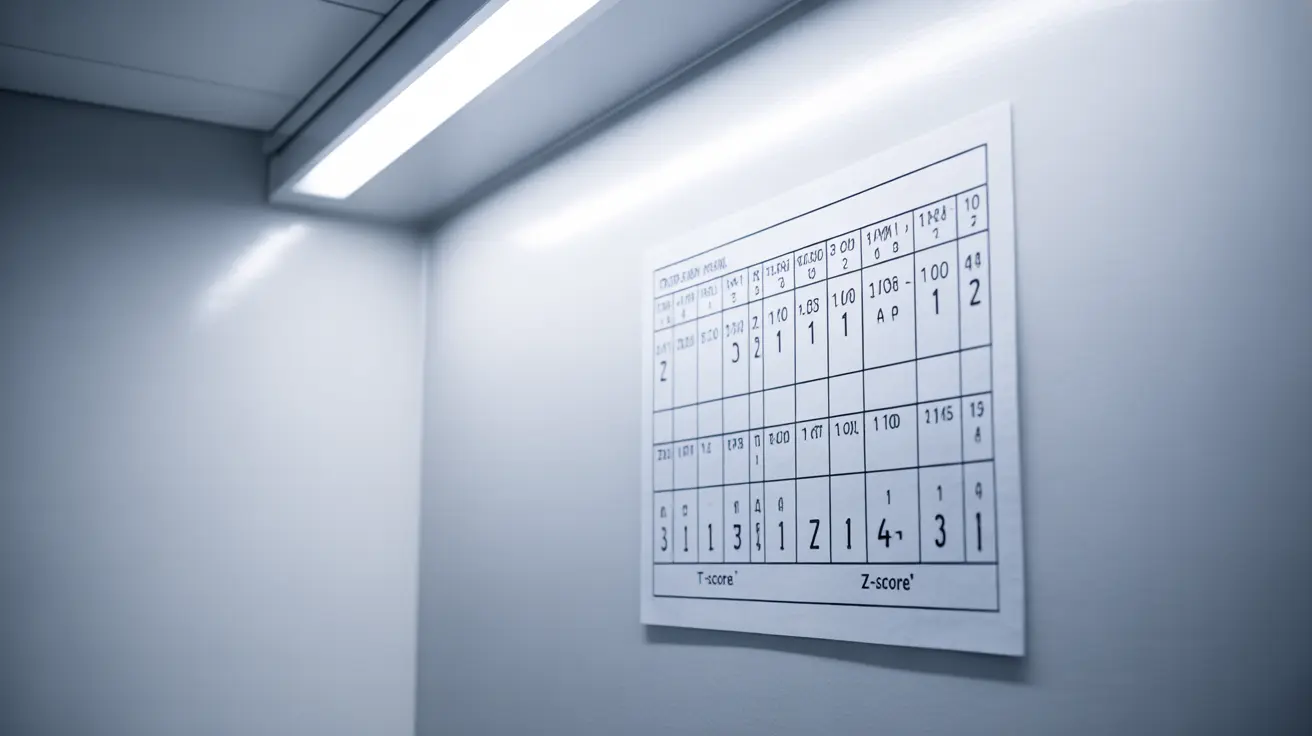When it comes to assessing bone health and diagnosing conditions like osteoporosis, healthcare providers rely on two important measurements from bone density tests: T-scores and Z-scores. Understanding the difference between these scores is crucial for interpreting your bone density test results and determining the most appropriate course of action for your bone health.
In this comprehensive guide, we'll explore how T-scores and Z-scores differ, their specific purposes, and what these measurements mean for different age groups. We'll also discuss how these scores help healthcare providers make informed decisions about diagnosis and treatment.
Understanding T-Scores
T-scores compare your bone density to that of a healthy young adult of the same gender at peak bone mass. This measurement is particularly relevant for postmenopausal women and men over 50, as it helps identify osteoporosis and assess fracture risk.
T-Score Interpretation
The World Health Organization (WHO) has established the following guidelines for interpreting T-scores:
- Normal bone density: T-score of -1.0 or higher
- Osteopenia (low bone mass): T-score between -1.0 and -2.5
- Osteoporosis: T-score of -2.5 or lower
Understanding Z-Scores
Z-scores compare your bone density to what's expected for someone of your age, gender, weight, and ethnic or racial origin. This measurement is especially important for premenopausal women, men under 50, and children, as it helps identify unusually low bone mass for age.
When Z-Scores Matter Most
Healthcare providers typically focus on Z-scores when evaluating:
- Children and adolescents
- Premenopausal women
- Men under age 50
- Patients with specific medical conditions affecting bone health
Key Differences and Clinical Applications
The primary difference between T-score and Z-score lies in their reference populations and clinical applications. T-scores use young adult peak bone mass as a reference, making them ideal for assessing age-related bone loss. Z-scores, meanwhile, compare you to age-matched peers, helping identify unusual bone loss that may be due to underlying medical conditions.
Factors Affecting Bone Density Scores
Several factors can influence your bone density scores:
- Genetics and family history
- Lifestyle factors (diet, exercise, smoking)
- Medical conditions
- Medications
- Hormonal changes
- Body weight and composition
Frequently Asked Questions
What is the difference between T-score and Z-score in bone density tests, and which one is more relevant for my age group?
T-scores compare your bone density to young adult peak bone mass and are most relevant for postmenopausal women and men over 50. Z-scores compare your results to age-matched peers and are more appropriate for premenopausal women, men under 50, and children. Your healthcare provider will focus on the most relevant score based on your age and medical history.
How do T-scores and Z-scores help diagnose osteoporosis and other bone health issues?
T-scores are used to diagnose osteoporosis when they fall at or below -2.5, while scores between -1.0 and -2.5 indicate osteopenia. Z-scores that are significantly low (usually below -2.0) suggest that bone loss may be due to factors other than age and merit further investigation of underlying conditions.
What are the typical causes of low Z-scores in younger individuals, and what further tests might be needed?
Low Z-scores in younger individuals may be caused by conditions such as malabsorption disorders, hormonal imbalances, or certain medications. Additional testing might include blood work to check vitamin D levels, hormones, and other markers of bone metabolism, as well as evaluation for specific medical conditions affecting bone health.
Are there any specific lifestyle changes or treatments that can improve bone density based on T-score or Z-score results?
Yes, interventions may include increasing calcium and vitamin D intake, engaging in weight-bearing exercise, quitting smoking, and limiting alcohol consumption. Depending on your scores and risk factors, your healthcare provider might also recommend medications to prevent bone loss or build bone density.
How often should I have a bone density scan if I have a family history of osteoporosis or other risk factors?
Generally, women over 65 and men over 70 should have regular bone density scans every 2-3 years. However, those with risk factors may need more frequent testing, typically every 1-2 years. Your healthcare provider will recommend an appropriate screening schedule based on your individual risk factors and previous test results.




